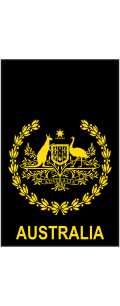| Royal Australian Navy | |
|---|---|
 | |
| Founded | 1 March 1901 |
| Country | |
| Branch | Navy |
| Role | Naval warfare |
| Size |
|
| Part of | Australian Defence Force |
| Headquarters | Russell Offices, Canberra |
| Mottos | To fight and win at sea [1] |
| March | "Royal Australian Navy" |
| Anniversaries | 10 July |
| Fleet | |
| Engagements | |
| Website | www |
| Commanders | |
| Chief of the Defence Force | Admiral David Johnston |
| Vice Chief of the Defence Force | Air Marshal Robert Chipman |
| Chief of Navy | Vice Admiral Mark Hammond |
| Deputy Chief of Navy | Rear Admiral Jonathan Earley |
| Commander Australian Fleet | Rear Admiral Christopher Smith |
| Insignia | |
| Naval ensign |  |
| Naval jack |  |
| Pennant | |
| King's Colours |  |
| Logo |  |
| Aircraft flown | |
| Multirole helicopter | MH-60R Seahawk |
| Trainer helicopter | EC-135T2+ |
The Royal Australian Navy (RAN) is the naval branch of the Australian Defence Force (ADF). The professional head of the RAN is Chief of Navy (CN) [2] Vice Admiral Mark Hammond. The Chief of Navy is also jointly responsible to the Minister for Defence (MINDEF) and the Chief of the Defence Force (CDF). The Department of Defence, which is a part of the Australian Public Service, supports the ADF, and ergo, the Royal Australian Navy. [3]
Contents
- History
- Formation
- World War I
- Interwar years
- World War II
- Post war to present
- Structure
- Command structure
- Fleet
- Clearance Diving Branch
- Personnel
- Ranks and uniforms
- Commissioned officers
- Sailors
- Rate insignia
- Ships and equipment
- Current ships
- Fleet Air Arm
- Armament
- Small arms
- Future
- Current operations
- See also
- References
- Notes
- Bibliography
- External links
The navy was formed in 1901 as the Commonwealth Naval Forces (CNF) through the amalgamation of the colonial navies of Australia following the federation of Australia. Although it was originally intended for local defence, it became increasingly responsible for regional defence as the British Empire started to diminish its influence in the South Pacific.
The Royal Australian Navy was initially a green-water navy, as the Royal Navy provided a blue-water force to the Australian Squadron, which the Australian and New Zealand governments helped to fund; the squadron was assigned to the Australia Station. This period lasted until 1913, when naval ships purchased from Britain arrived, although the British Admiralty continued to provide blue-water defence capability in the Pacific and Indian Oceans up to the early years of the Second World War. [4]
During its history, the Royal Australian Navy has participated in a number of major wars, including the First and Second World Wars, Korean War, Malayan Emergency, Indonesia-Malaysia Confrontation and the Vietnam War. As of 2025, the RAN consists of 36 commissioned vessels, 12 non-commissioned vessels and over 16,000 personnel. The navy is one of the largest and most sophisticated naval forces in the South Pacific region, with a significant presence in the Indian Ocean and worldwide operations in support of military campaigns and peacekeeping missions.



















































